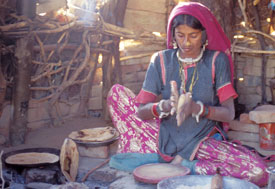The chronic challenge of household air pollution
September / October 2011 | Volume 10, Issue 5

Photo by Curt Carnemark/World Bank
From studies stretching over three decades, Fogarty
grantee Dr. Kirk R. Smith has linked household air
pollution to chronic obstructive pulmonary disease,
cataracts, pneumonia, TB and heart disease.
By Steve Goldstein
Cooking the family meal is a universal activity but one with deadly consequences in much of the developing world. Unventilated, smoky stoves used for food preparation - together with many home heating sources - pose a significant threat.
From studies stretching over three decades, Fogarty grantee Dr. Kirk R. Smith has linked household air pollution (HAP) to chronic obstructive pulmonary disease, cataracts, pneumonia, TB and heart disease. Almost 90 percent of deaths from COPD occur in low- and middle-income countries, many in nonsmoking populations.
Low birth weight may also result from household air pollution, Smith’s studies have shown, which can have consequences over an entire lifetime, including increased risk of diabetes and other chronic diseases.
Household air pollution from combustion of solid fuels - such as wood, crop residues, animal dung, grasses and coal - used for cooking and space heating is one of the ten most important risk factors in the global burden of disease. In poor countries, indoor smoke from solid fuels accounts for an estimated 3.7 percent of the total disease burden. In India, approximately 70 percent of the population uses biomass fuel for cooking.
“There’s only one environmental risk factor that operates 100 percent among the poorest and that’s household air pollution,” said Smith, a researcher and faculty member at the University of California, Berkeley.
He says his biggest success is at Sri Ramachandra University in Chennai, India. Last year it launched the first master’s program in environmental and occupational health in South Asia, thanks to six faculty trained at UC Berkeley with support from Fogarty’s International Research and Training Program in Environmental and Occupational Health. Dr. Sambandam Sankar - who earned his Ph.D. through this collaboration - is now recognized as one of India’s leading experts on household air pollution research.
“Until this collaboration took place, studies and databases on household air pollution were limited, in spite of having recognized HAP as a major risk factor for many of health impacts,” Sankar said in an interview. “This led to a large-scale HAP assessment study that created a baseline exposure database for particulate matter associated with combustion of household solid fuel combustion in rural areas of southern India.”
The specialized training in exposure assessment and advanced epidemiologic methods they received at UC Berkeley, prepared the Indian scientists to develop standard operating procedures used throughout the country.
Sankar said the Fogarty grants not only provided the opportunity to interact with Berkeley counterparts, but also led to broader exposure to the research community. “The support allowed us to present our findings at international conferences, thereby increasing the publishing potentials in international journals,” he said.
Grant writing instruction offered as part of the training generated five proposals from institutions in Nepal and India, four of which were funded through Fogarty. Two of the studies, including one linking tuberculosis and indoor biomass and kerosene use in Nepal, have been published. Other research questions have focused on the amount of particulate matter produced by HAP and effects on pulmonary function.
Smith and his colleagues have also been testing the effectiveness of the numerous models of cookstoves that have been developed to make indoor cooking safer. Their latest effort is a Fogarty-supported feasibility study of a program to provide advanced cookstoves to pregnant women as part of their prenatal care benefit package in India. If the pilot study shows women will actually use the stoves, they will work to scale up the effort in a much larger trial.
More Information
To view Adobe PDF files,
download current, free accessible plug-ins from Adobe's website.